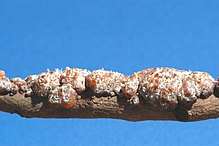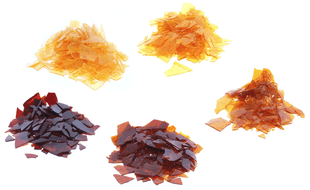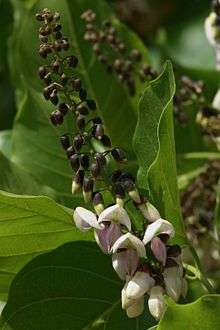Lac
Lac is the resinous secretion of a number of species of lac insects, of which the most commonly cultivated is Kerria lacca.


Cultivation begins when a farmer gets a stick that contains eggs ready to hatch and ties it to the tree to be infested.[1] Thousands of lac insects colonize the branches of the host trees and secrete the resinous pigment. The coated branches of the host trees are cut and harvested as sticklac.
The harvested sticklac is crushed and sieved to remove impurities. The sieved material is then repeatedly washed to remove insect parts and other material. The resulting product is known as seedlac. The prefix seed refers to its pellet shape. Seedlac, which still contains 3–5% impurity, is processed into shellac by heat treatment or solvent extraction.
The leading producer of lac is Jharkhand, followed by the Chhattisgarh, West Bengal, and Maharashtra states of India. Lac production is also found in Bangladesh, Myanmar, Thailand, Laos, Vietnam, parts of China, and Mexico.
Etymology
The word lac is derived from the Sanskrit word lākshā' (लाक्षा), which represents the number 100,000. It was used for both the lac insect (because of their enormous number) and the scarlet resinous secretion it produces. This resin has been used for making traditional and tribal bangles,[2] and still used as sealing wax by the India Post.[3] It is also used as wood finish, skin cosmetic and dye for wool and silk in ancient India and neighbouring areas.[4][5] Lac resin was once imported in sizeable quantity into Europe from India along with Eastern woods.[6][7]
Host trees

Kerria lacca can be cultivated on either cultivated or wild host plants.
- In India the most common host plants are:
- Dhak (Butea monosperma)
- Ber (Ziziphus mauritiana)
- Kusum (Schleichera oleosa) (reported to give the best quality and yield)[8]
- In Thailand the most common host plants are
- Rain tree (Albizia saman)
- Pigeon pea (Cajanus cajan)
- In China the common host plants include
- Pigeon pea ([Cajanus cajan)
- Hibiscus species
- In Mexico
- Barbados nut (Jatropha curcas)
Estimated yields per tree in India are 6–10 kg for kusum, 1.5–6 kg for ber, and 1–4 kg for dhak.[9] The bugs' life cycles can produce two sticklac yields per year, though it may be better to rest for six months to let the host tree recover.[10]
Harvesting
Lac is harvested by cutting the tree branches that hold sticklac. If dye is being produced, the insects are kept in the sticklac because the dye colour comes from the insects rather than their resin. They may be killed by exposure to the sun.[9]
On the other hand, if seedlac or shellac is being produced, most insects can escape because less coloured pale lac is generally more desired.[9]
Uses
The use of lac dye goes back to ancient times. It was used in ancient India and neighbouring areas as wood finish, skin cosmetic and dye for wool and silk.[4][5][9] In China it is a traditional dye for leather goods. Lac for dye has been somewhat replaced by the emergence of synthetic dyes,[9] though it remains in use, and some juices, carbonated drinks, wine, jam, sauce, and candy are coloured using it.[11]
Lac is used in folk medicine as a hepatoprotective and anti-obesity drug. It is used in violin and other varnish and is soluble in alcohol. This type of lac was used in the finishing of 18th-century fowling guns in the United States.
Production levels
India exported significant amounts of sticklac derivatives, especially lac dye, from the 1700s to the late 1800s. Production declined as synthetic dyes emerged, and after the late 1940s, production of seedlac and shellac also declined due to replacement.[9]
In the mid-1950s, India annually produced about 50,000 tons of sticklac and exported about 29,000 tons of lac; by the late 1980s the figures were about 12,000 tons and 7,000 tons, respectively. By 1992–93, India's lac exports fell further to 4,500 tons. In the same period, Thailand's production increased somewhat, with annual lac exports of around 7,000 tons in the 1990s, mainly of seedlac. China exported only about 500 tons of shellac per year in the 1990s but produced more lac internally: 4,000-5,000 tons of sticklac and 2,000–3,000 tons of shellac in Yunnan province, with additional, smaller production in Fujian province. While India, Thailand, and China are the major lac producers, Bangladesh, Myanmar, Vietnam, and Sri Lanka also play small roles.[9]
Description in ancient texts
Usage of lac/lah/laksha is described in ancient Hindu literature Atharvaveda also. Kand 5 and Sukta 5 (chapter 5, verse 5) is called as Laksha Sukti - verse related to lac. This entire verse is dedicated to lac and its usage. It has description of many ancient practices. For example - The second sloka of this verse clearly states: "Those who drink you (lac), live long. You give life to human and make them disease free".
Species
- Kerria lacca – the true lac scale
- Paratachardina decorella – the rosette lac scale
- Paratachardina pseudolobata – the lobate lac scale
See also
References
- Derry, Juliane (2012). "Investigating Shellac: Documenting the Process, Defining the Product" (PDF). Project-Based Masters Thesis, University of Oslo. p. 27. Retrieved 3 July 2014.
- "The art of making lac bangles.", Gaatha.com.
- "The art of sealing.", itokri.com.
- Franco Brunello (1973), The art of dyeing in the history of mankind, AATCC, 1973,
... The word lacquer derives, in fact, from the Sanskrit 'Laksha' and has the same meaning as the Hindi word 'Lakh' which signifies one-hundred thousand ... enormous number of those parasitical insects which infest the plants Acacia catecu, Ficus and Butea frondosa ... great quantity of reddish colored resinous substance ... used in ancient times in India and other parts of Asia ...
- Ulrich Meier-Westhues (November 2007), Polyurethanes: coatings, adhesives and sealants, Vincentz Network GmbH & Co KG, 2007, ISBN 978-3-87870-334-1,
... Shellac, a natural resin secreted by the scaly lac insect, has been used in India for centuries as a decorative coating for surfaces. The word lacquer in English is derived from the Sanskrit word laksha. which means one hundred thousand ...
- Donald Frederick Lach; Edwin J. Van Kley (1994-02-04), Asia in the making of Europe, Volume 2, Book 1, University of Chicago Press, 1971, ISBN 978-0-226-46730-6,
... Along with valuable woods from the East, the ancients imported lac, a resinous incrustation produced on certain trees by the puncture of the lac insect. In India, lac was used as sealing wax, dye and varnish ... Sanskrit, laksha; Hindi, lakh; Persian, lak; Latin, lacca. The Western word "lacquer" is derived from this term ...
- Thomas Brock; Michael Groteklaes; Peter Mischke (2000), European coatings handbook, Vincentz Network GmbH & Co KG, 2000, ISBN 978-3-87870-559-8,
... The word "lacquer" itself stems from the term "Laksha", from the pre-Christian, sacred Indian language Sanskrit, and originally referred to shellac, a resin produced by special insects ("lac insects") from the sap of an Indian fig tree ...
- Iwasa, S, 1997. Schleichera oleosa (Lour.) Oken. In Faridah Hanum, I. & van der Maesen, L.J.G. (Eds.): Plant Resources of South-East Asia No. 11. Auxiliary Plants. Prosea Foundation, Bogor, Indonesia. pp. 227-229.
- Green, C. L. (1995). "5: Insect Dyes". Non-Wood Forest Products 4: Natural colourants and dyestuffs. Rome: Food and Agriculture Organization of the United Nations. Retrieved 3 July 2014.
- Derry, Juliane (2012). "Investigating Shellac: Documenting the Process, Defining the Product" (PDF). Project-Based Masters Thesis, University of Oslo. p. 28. Retrieved 3 July 2014.
- Flinn, Angel (15 Aug 2011). "Shellac & Food Glaze". Gentle World. Retrieved 3 July 2014.
External links
| Wikisource has the text of the 1911 Encyclopædia Britannica article Lac. |

- Indian Institute of Natural Resins and Gums - IINRG, formerly Indian Lac Research Institute - ILRI
- FAO - Insect dyes - Lac - Summary of Basic Information